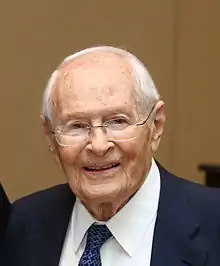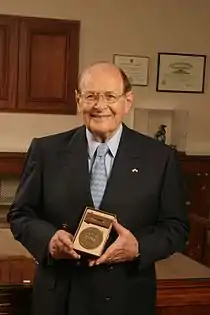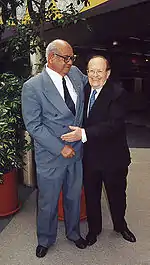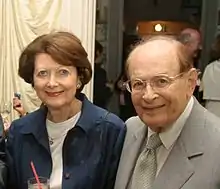George Rosenkranz
George Rosenkranz (born György Rosenkranz; 20 August 1916 – 23 June 2019) was a pioneering Mexican scientist in the field of steroid chemistry, who used native Mexican plant sources as raw materials.[2][3] He was born in Hungary, studied in Switzerland and emigrated to the Americas to escape the Nazis, eventually settling in Mexico.[2][4]
George Rosenkranz | |
|---|---|
 George Rosenkranz receiving the Biotechnology Heritage Award in Chicago, 2013 | |
| Born | 20 August 1916 |
| Died | 23 June 2019 (aged 102) |
| Nationality | Mexican[1] |
| Known for | Synthesis of norethisterone, the first orally highly active progestin, used in one of the first oral contraceptive pills |
| Scientific career | |
| Fields | Chemist |
At Syntex corporation in Mexico City, Rosenkranz assembled a research group of organic chemists that included future leaders from around the world, such as Carl Djerassi, Luis E. Miramontes and Alejandro Zaffaroni[5][6][7][8][9][10] Revolutionary advances in the understanding of steroid drugs and their production occurred under Dr Rosenkranz's direction.[11] Syntex synthesized a progestin used in some of the first combined oral contraceptive pills and numerous other useful steroids. Under Rosenkranz's leadership, Syntex became "a powerful international force in the development of steroidal pharmaceuticals",[12] and "a pioneer of biotechnology" in the San Francisco Bay Area. Rosenkranz stepped down as CEO in 1982, at the age of 65.[13]
In 2012, he was awarded the Biotechnology Heritage Award, in recognition of his significant contributions to the development of biotechnology through discovery, innovation, and public understanding.[8] He turned 100 in August 2016.[14]
Rosenkranz was also an American Contract Bridge League (ACBL) Grand Life Master at his hobby of duplicate bridge, with more than 13,000 masterpoints and 12 NABC titles (below). He wrote or co-wrote more than 10 books on bridge.[15]
Scientific research
| External video | |
|---|---|
 | |
Rosenkranz was born in 1916 in Budapest, Hungary,[13] the son of Etel (Weiner) and Bertalan Rosenkranz.[16] Rosenkranz studied chemistry at the Swiss Federal Institute of Technology, where he received his doctorate.[13] His mentor, future Nobel Prize winner Lavoslav Ružička, began Rosenkranz's interest in steroid research. However, Nazi sympathizers were active in Zurich. Ružička shielded Rosenkranz and other Jewish colleagues, but their presence put their mentor at risk. "We got together and we decided to leave Switzerland to protect him," Rosenkranz said in a 2002 article for the Pan American Health Organization's magazine.[4]
Ružička arranged an academic position for Rosenkranz in Quito, Ecuador. While Rosenkranz was waiting in Havana, Cuba, for a ship to Ecuador, the Japanese attacked Pearl Harbor. The United States immediately entered World War II. Unable to go to Ecuador, Rosenkranz accepted the Cuban president Fulgencio Batista's offer allowing refugees to stay in the country and work. He found work at the Vieta Plasencia Lab, where he was asked to develop treatments for venereal disease.[3]
The important role of hormones in human health was already known, but ways to synthesize them were unknown. George Rosenkranz's skills as a chemist attracted the interest of Emeric Somlo, a Hungarian immigrant, and Dr. Federico Lehmann at Syntex in Mexico City, Mexico.[17] They had formed the company in 1944 to work with Russell Marker, a Penn State professor, and sought to synthesize the hormone progesterone from diosgenin-containing Mexican yams, which would eventually give rise to the Mexican barbasco trade.[18]:183 After a disagreement Marker left, taking his steroid knowledge with him. Rosenkranz was recruited to replace him, and moved to Mexico City in 1945.[4][5]
Rosenkranz faced the challenge of analyzing Marker's samples to identify their ingredients and reverse engineering Marker's chemical production processes. He didn't have much help: his initial staff included nine lab assistants and only one other chemist,[19] and Mexico lacked a Ph.D. program in chemistry.[20]
When he couldn't find enough fully trained local chemists, Rosenkranz recruited researchers from Mexico and around the world. Rosenkranz also helped to create an institute of chemistry, the Instituto de Química (Universidad Nacional Autónoma de México), now considered "a flagship in Mexico's ethnobotanical research".[21] He was able to attract significant synthetic organic chemists as researchers and instructors and to obtain funding to expand programs for the training of organic chemists. He and his colleagues regularly worked at Syntex during the day and then spent the evenings teaching chemistry. Rosenkranz also helped to start the Institute for Molecular Biology in Palo Alto.[20]
Attracting young chemists such as Carl Djerassi, Luis E. Miramontes and Alejandro Zaffaroni was critical to Syntex's first big success.[5][6] Luis E. Miramontes, George Rosenkranz and Carl Djerassi synthesis of norethindrone, later proven to be an effective pregnancy inhibitor, led to an infusion of capital in Syntex and Mexican steroid pharma industry.[22] The Mayo clinic had reported that the steroid hormone cortisone was an effective anti-inflammatory, capable of relieving painful rheumatoid arthritis symptoms. However, as described by Djerassi, "Until 1951, the only source of cortisone was through an extraordinarily complex process of 36 different chemical transformations starting from animal bile acids."[23] Several prominent groups of international scientists were attempting to be the first to synthesize cortisone. Rosenkranz's team started working in two shifts, and their dedication paid off. In 1951, Rosenkranz, Djerassi, and their fellow researchers submitted a paper on the synthesis of cortisone, edging out reports from Harvard and Merck by a matter of weeks.[9][24][25][26]

Having successfully synthesized cortisone, the researchers at Syntex continued to work on the synthesis of progesterone. A female sex hormone, progesterone was used to help pregnant women avoid miscarriages, and to treat infertility.[23] Five months later, under the direction of Rosenkranz and Carl Djerassi, the last step of the synthesis of norethisterone (norethindrone) was successfully completed by Luis E. Miramontes, and Syntex applied for a patent, which was granted as US patent 2,744,122 on May 1, 1956.[4][25][27] Syntex initially reached an agreement with the American company Parke-Davis to market norethisterone as Norlutin for the treatment of gynecological disorders, which was approved by the FDA in 1957.[28] Parke-Davis however refused to develop Syntex's norethisterone as a contraceptive over concerns about a possible Catholic boycott of its other products.[29] This delay placed Syntex at a disadvantage, but by 1962, they had partnered with Johnson & Johnson's Ortho division to introduce the birth control pill Ortho-Novum, which used Syntex's norethisterone.[20][28][30] In March 1964, the FDA approved Syntex's version of Ortho-Novum with the brand name Norinyl (norethisterone 2 mg + mestranol 100 µg).[20][30][31] In March 1964, the FDA also approved Parke-Davis's version of the German company Schering's oral contraceptive Anovlar with the brand name Norlestrin (norethisterone acetate 2.5 mg + ethinylestradiol 50 µg).[31]
Rosenkranz understood the importance of peer recognition, not just commercial success, to the scientists who worked for him. He has said, "To have people work productively, you have to build an intellectually challenging environment, allow creative freedom, and insure peer recognition and respect for the individual."[32] A cascade of papers on steroid chemistry issued from the Rosenkranz lab during the 1940s and 1950s.[9][20] Rosenkranz himself is the author or co-author of over 300 articles in steroid chemistry and is named on over 150 patents.[8]
Rosenkranz gave up his executive positions at Syntex in 1981.[8] Although technically retired for over three decades, Rosenkranz was still active in the industry. In 1996, he became a member of the board of Digital Gene Technologies[33] He was also president of the advisory board of ICT Mexicana.[32] He died at the age of 102 on 23 June 2019.[16]
Scientific Memberships
- National Academy of Medicine of Mexico
- New York Academy of Science
- University of Tel Aviv boardmember
- Weizmann Institute of Science in Rehovot, Israel, boardmember
Scientific Awards
- 2013 Biotechnology Heritage Award, from the Biotechnology Industry Organization (BIO) and the Chemical Heritage Foundation[8][34]
- 2004 Winthrop-Sears Medal, from the Chemical Heritage Foundation and The Chemists' Club, with Alexander Zaffaroni[35][36]
- 2001 Condecoracion Eduardo Liceaga, Mexican highest award for contributions to the health field.[37]
- 1994 Dr. Leopoldo Rio de la Loza, Mexican National Prize in Pharmaceutical Sciences[13]
- Leadership Award of the Mexican Health Federation[8]
Bridge

Rosenkranz was a world-class bridge player and one of the most successful in Mexico. He won 12 NABC-level events at thrice-annual North American Bridge Championships meets, including all four major teams-of-four titles: the Grand Nationals, Reisinger, Spingold and Vanderbilt. In world championship teams competition, he represented Mexico in the quadrennial World Team Olympiad three times from 1972 to 1996 and the United States in the 1983 Bermuda Bowl.[38] In addition, he has made significant contributions to bidding theory. He created the Romex bidding system, an extension of Standard American with many gadgets. He invented the Rosenkranz double and Rosenkranz redouble,[39] and wrote more than a dozen books on bridge.[4]
Edith Rosenkranz's kidnapping
In July 1984, Rosenkranz' wife Edith was kidnapped at the summer North American Bridge Championships in Washington, D.C., by Glenn I. Wright and Dennis Moss, and ransomed for one million dollars. The FBI and the District of Columbia police captured Wright and Moss, and she was returned safely.[40] The ransom money was later recovered and the two kidnappers were later convicted and sentenced, as was a third defendant, Orland D. Tolden.[41] Wright was released in 1999, Moss in 1994, and Tolden in 1989.[42]
Bridge awards
- ACBL Hall of Fame, Blackwood Award 2000[43]
- ACBL Honorary Member 1990
- Precision Award 1976
Tournament wins and runners-up
- Wins
- North American Bridge Championships (12)
- Master Mixed Teams (1) 1990
- Open Swiss Teams (1) 1991
- North American Swiss Teams (1) 1990
- Grand National Open Teams (1) 1981
- Men's Board-a-Match Teams (2) 1984, 1987
- Reisinger Board-a-Match Teams (1) 1985
- Spingold Knockout Teams (2) 1976, 1984
- Vanderbilt Knockout Teams (3) 1975, 1976, 1982
- Runners-up
- North American Bridge Championships (15)
- Blue Ribbon Pairs (1) 1974
- Silver Ribbon Pairs (1) 1992
- Master Mixed Teams (3) 1967, 1984, 1994
- Open Swiss Teams (2) 1998, 2003
- Men's Board-a-Match Teams (1) 1975
- Open Board-a-Match Teams (2) 1990, 2000
- Spingold Knockout Teams (1) 1967
- Vanderbilt Knockout Teams (2) 1978, 2001
- Reisinger Board-a-Match Teams (2) 1980, 1997
- Other notable 2nd places:
- United States Bridge Federation Bermuda Bowl qualifiers (1) 1982
Publications
| Library resources about George Rosenkranz |
| By George Rosenkranz |
|---|
- Bridge books by Rosenkranz
- The Romex System of Bidding: a dynamic approach to bridge (New York: World Publishing Co., 1970)
- Win with Romex: the key to accurate bidding (Crown Publishers, 1975)
- Bid Your Way to the Top (New York state: Barclay Bridge Supplies, 1978)
- Bridge, the Bidder's Game (Louisville, KY: Devyn Press, 1985)
- Slam Bidding (Devyn, 1985) – Championship bridge series, no. 33
- Everything You Always Wanted to Know About Trump Leads and Were Not Afraid to Ask (Devyn, 1986)
- Tips for Tops (Devyn, 1988)
- More Tips for Tops (Devyn, 1991)
- Our Man Godfrey: tales from the bridge table (Devyn, 1994), ed. Phillip Alder – love story and bridge instruction
- Bridge by Rosenkranz and co-authors
- Modern Ideas in Bidding (Devyn, 1982), with Alan Truscott
- Bid to Win, Play for Pleasure (Devyn, 1990), with Alder
- Bidding on Target (Devyn, 1992), with Truscott and Alder
- Godfrey's Bridge Challenge (Devyn, 1996), with Alder
- Godfrey's Stairway To The Stars: a step-by-step guide to modern bidding (Devyn, 1998), with Alder
- Godfrey's Angels (Devyn, 2001), with Alder
The four Godfrey books combine fictional narrative and instructional bridge. The second, and first with co-author credit to Phillip Alder, Godfrey's Bridge Challenge "brings the Romex system to life through lively anecdotes instruction and quizzes". The last, Godfrey's Angels incorporates 1998–2001 improvements in the system.[44][45]
- Memoir
References
- "La píldora anticonceptiva, ¿es de 'padres' mexicanos?". Excélsior. 2014-03-10. Retrieved 30 May 2015.
Rosenkranz se nacionalizó mexicano, siguió trabajando en Syntex por muchos años, actualmente vive en México y tiene 98 años.
- Ness, Roberta B. (2013). Genius unmasked. Oxford: Oxford Univ. Press. ISBN 9780199976591.
- "Scientists You Must Know: Pioneering steroid researcher George Rosenkranzh (Video)". Science History Institute. June 2016. Retrieved 21 February 2018.
- Cohen, Gerald S. (2002). "Mexico's Pill Pioneer". Perspectives in Health Magazine: The Magazine of the Pan American Health Organization. 7 (1). Retrieved 6 February 2014.
- Kornberg, Arthur (2002). The golden helix : inside biotech ventures. Sausalito, Calif.: University Science Books. p. 72. ISBN 9781891389191.
- USA Science & Engineering Festival – Role Models in Science & Engineering Achievement Archived 2014-08-06 at the Wayback Machine. Retrieved 1 Oct 2014.
- Juaristi, Eusebio (2 May 2003). "A few comments on the development of organic chemistry in Mexico". Arkivoc. 2003 (11): 1. doi:10.3998/ark.5550190.0004.b01. Retrieved 15 May 2014.
- "George Rosenkranz to Receive 2013 Biotechnology Heritage Award". April 21, 2013. Chemical Heritage Foundation. Archived from the original on July 12, 2016.
- Morell, Virginia (23 January 1989). "Rewards Of Intellectual Bigamy". The Scientist. Retrieved 16 May 2014.
- "American Chemical Society International Historic Chemical Landmarks. The "Marker Degradation" and Creation of the Mexican Steroid Hormone Industry 1938-1945". American Chemical Society. Retrieved 15 May 2014.
- "Steroid pioneer gets Heritage Foundation, BIO award". BioSpectrum. 22 April 2013. Archived from the original on 3 May 2013. Retrieved 7 February 2014.
- Raber, Linda (25 October 1999). "Steroid Industry Honored". ACS News. 77 (43): 78–80.
- Center for Oral History. "George Rosenkranz". Science History Institute.
- Staff (2016-07-12). "Honoring The 100th Birthday of George Rosenkranz, PH.D." congress.gov. Retrieved 2016-08-21.
- "Rosenkranz, George". Hall of Fame. American Contract Bridge League (ACBL). Archived from the original on 17 September 2016. Retrieved 18 December 2014.
- The New York Times. "George Rosenkranz, a Developer of the Birth Control Pill, Dies at 102".
- "Marker Degradation: Creation of the Mexican Steroid Hormone Industry" (PDF). American Chemical Society. Retrieved June 9, 2015.
- Sismondo, Sergio; Greene, Jeremy A. (2015-05-11). The Pharmaceutical Studies Reader. John Wiley & Sons. ISBN 9781118490150.
- Rosenkranz, George (2005). "The early days of Syntex" (PDF). Chemical Heritage Magazine. Retrieved 16 May 2014.
- Mandaro, Laura (8 August 2005). "Scientist George Rosenkranz; Innovate: His determination helped millions ease their pain, plan their families". Investor's Business Daily. Retrieved 7 February 2014.
- Laveaga, Gabriela Soto (2009). Jungle laboratories : Mexican peasants, national projects, and the making of the Pill. Durham [NC]: Duke University Press. p. 61. ISBN 978-0822346050.
- George Rosenkranz, 102, a Developer of the Birth Control Pill, Is Dead: https://www.nytimes.com/2019/06/23/obituaries/george-rosenkranz-dies-at-102.html
- Flavell-While, Claudia (June 2010). "Engineering the sexual revolution" (PDF). The Chemical Engineer: 46–47. Archived from the original (PDF) on 13 January 2014. Retrieved 16 May 2014.
- Rosenkranz, G.; Djerassi, Carl; Yashin, R.; Pataki, J. (7 July 1951). "Cortical Hormones from alloSteroids: Synthesis of Cortisone from Reichstein's Compound D". Nature. 168 (4262): 28. doi:10.1038/168028a0. PMID 14852935.
- Djerassi, C (Dec 1992). "Steroid research at Syntex: "the pill" and cortisone". Steroids. 57 (12): 631–41. doi:10.1016/0039-128X(92)90016-3. PMID 1481227.
- Padgett, John F.; Powell, Walter W., eds. (2012). The emergence of organizations and markets. Princeton: Princeton University Press. p. 409. ISBN 978-0691148878.
- US patent 2744122
- Tyrer, Louise (January 1999). "Introduction of the Pill and Its Impact". Contraception. 59 (1 Supplement): 11S–16S. doi:10.1016/S0010-7824(98)00131-0. PMID 10342090. reprinted in:
Tyrer, Louise (2011). "Introduction of the Pill and Its Impact". In Schneider, Dona; Lilienfeld, David E. (eds.). Public Health: The Development of a Discipline, Volume 2, Twentieth-Century Challenges. New Brunswick, N.J.: Rutgers University Press. pp. 277–287. ISBN 978-0-8135-5009-1. p. 279 - Li, Jie Jack (2008). Triumph of the heart : the story of statins. New York: Oxford University Press. p. 79. ISBN 978-0195323573.
- Watkins, Elizabeth Siegel (2007). The estrogen elixir : a history of hormone replacement therapy in America. Baltimore: Johns Hopkins Univ. Press. ISBN 978-0801868214.
- AP (March 4, 1964). "3 new oral contraceptives approved for sale in U.S." The New York Times. p. 27.
- "Dr. George Rosenkranz Calls for Increased Commitment to Science and Research". BusinessWire. 31 October 2001. Retrieved 16 May 2014.
- "Digital Gene Technologies names Dr. George Rosenkranz to board of directors; former chairman, president and CEO of Syntex Corp. to assist in corporate development efforts". Business Wire. 4 September 1996. Retrieved 16 May 2014.
- "Biotechnology Heritage Award". Science History Institute. 2016-05-31. Retrieved 21 February 2018.
- Tweedy, Bryan D. (2004). "Honoring Syntex's 'Big Three'" (PDF). Modern Drug Discovery. August: 29. Retrieved 16 May 2014.
- "Winthrop-Sears Medal". Science History Institute. 2016-05-31. Retrieved 21 February 2018.
- Sellers, L. J. (March 1, 2002). "Pioneering the Pill". Pharmaceutical Executive.
- "George Rosenkranz: Mexico" Archived 2014-10-06 at the Wayback Machine. World Bridge Federation (worldbridge.org). Retrieved 18 December 2014.
- Francis, Henry G.; Truscott, Alan F.; Francis, eds. (2001). The Official Encyclopedia of Bridge (6th ed.). Memphis, TN: American Contract Bridge League. p. 392-93. ISBN 0-943855-44-6. OCLC 49606900.
- Kay-Wolff, Judy (3 December 2011). "Time Marches On ..." BRIDGEBLOGGING. Retrieved 6 February 2014.
- List of kidnappings
- https://www.bop.gov/inmateloc/
- "Induction by Year". Hall of Fame. ACBL. Retrieved 18 December 2014.
- "Items by George Rosenkranz". The Bridge World. Retrieved 16 May 2014.
- "Bridge books reviewed – 53". Pattaya Bridge Club (Pattaya, Thailand). Retrieved 16 May 2014.
External links
Scientific work
- Center for Oral History. "George Rosenkranz". Science History Institute.
- Scientists You Must Know: Pioneering steroid researcher George Rosenkranzh, Video, from the Scientists You Must Know Film Series, Science History Institute, Philadelphia, PA
- Cohen, Gerald S. (2002). "Mexico's Pill Pioneer". Perspectives in Health Magazine: The Magazine of the Pan American Health Organization. 7 (1). Retrieved 6 February 2014.
Bridge
- "International record for George Rosenkranz". World Bridge Federation.
- Citation at the ACBL Hall of Fame
- George Rosenkranz at Library of Congress Authorities, with 2 catalog records
- List of bridge books by writer, R at Bridge Guys
